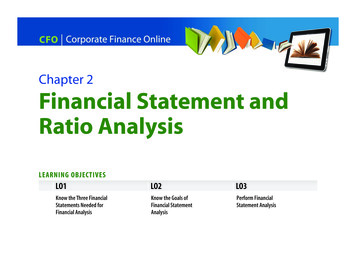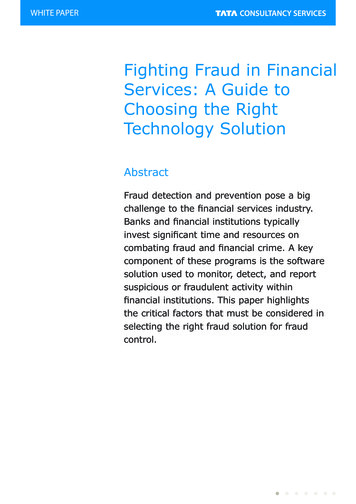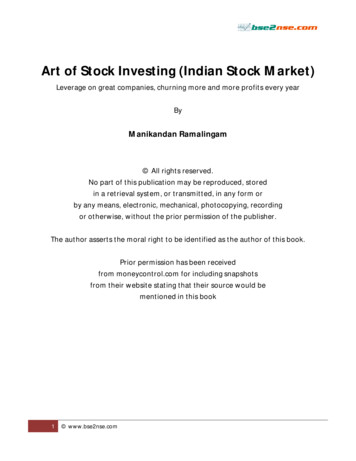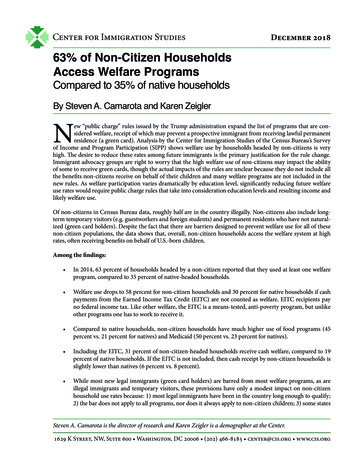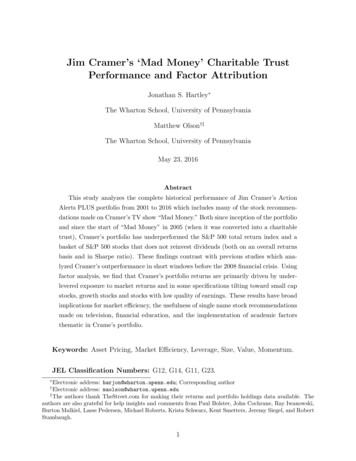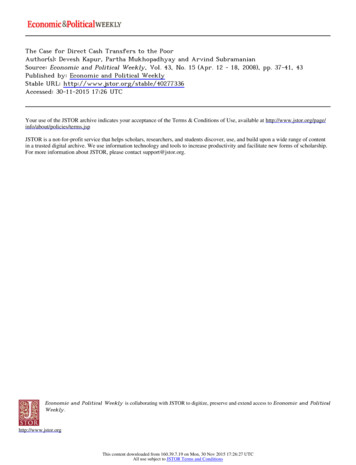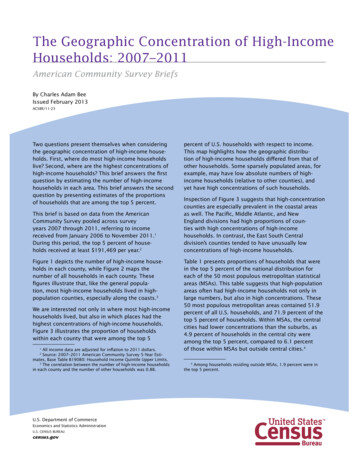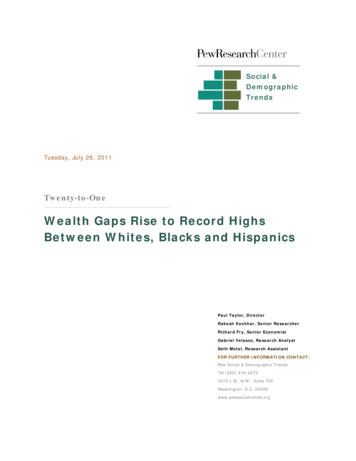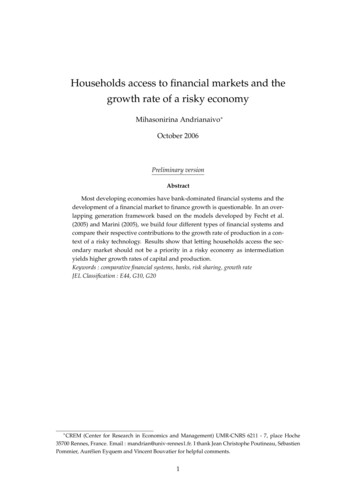
Transcription
Households access to financial markets and thegrowth rate of a risky economyMihasonirina Andrianaivo October 2006Preliminary versionAbstractMost developing economies have bank-dominated financial systems and thedevelopment of a financial market to finance growth is questionable. In an overlapping generation framework based on the models developed by Fecht et al.(2005) and Marini (2005), we build four different types of financial systems andcompare their respective contributions to the growth rate of production in a context of a risky technology. Results show that letting households access the secondary market should not be a priority in a risky economy as intermediationyields higher growth rates of capital and production.Keywords : comparative financial systems, banks, risk sharing, growth rateJEL Classification : E44, G10, G20 CREM (Center for Research in Economics and Management) UMR-CNRS 6211 - 7, place Hoche35700 Rennes, France. Email : mandrian@univ-rennes1.fr. I thank Jean Christophe Poutineau, SébastienPommier, Aurélien Eyquem and Vincent Bouvatier for helpful comments.1
1IntroductionFinancial systems affect economic growth.1 It is a crucial question in developedeconomies and is even more important for less developed countries. Developingeconomies are indeed seeking ways of financing their economic growth as they strongly depend on external fundings but face a reduction of international aid flows today.The Washington Consensus of the early 1990s defends policies promoting economicgrowth based on the role of the markets.2 In fact, liberal approach argues that markets are more effective than banking indebtedness, however, history in developedcountries has proved that these two logics of financing (banks and markets) are morecomplementary than completely opposed.3 In less developed countries, financial systems are generally bank-dominated and even though banks are excessively liquid,they offer very little credit to the private sector and prefer to invest in Treasury Bondswhich finance budget deficits. 4 Reforms of the financial system are therefore a matterof concern and question the opportunity (in terms of economic growth) for countriesto develop alternative sources of financing for firms and to develop financial markets.Empirical models have shown that even if financial development is good for economic growth, the bank or market-based structure is equivalent as what matters isquality of financial services and legal rights (Levine (2002), Allen and Gale (2001)).As a matter of fact, Levine (2004) provides an exhaustive survey on the empiricaland theoretical conclusions drawn and yet the debate does not seem closed. We provide an original answer to that traditional question using existing models of financialintermediation.Theoretical models of financial intermediation are generally based on the seminalpaper by Diamond and Dybvig (1983). This paper accounts for intermediaries performing intertemporal risk sharing whereas Allen and Gale (1997, 2003) distinguishtwo types of risks : intertemporal risk sharing, when risks are shared across time,and cross sectional or aggregate risk sharing when agents exchange risks at a pointin time. Nevertheless few models embed this framework in a growth model to account both for the financial structure and its impact on economic growth. Fecht et al.1See Levine (1997) for a survey on this litteratureThe Consensus recommends economic reforms such as fiscal discipline, competitive exchange rates,trade liberalisation, foreign investments, privatisations and deregulation.3For instance, in Anglo-Saxon countries, markets dominate while in Germany, banks play a moresignificant part and in Japan, indebtedness was used to finance growth. See also Schumpeter (1934),Goldsmith (1969), Gurley and Shaw (1955).4For instance, in Madagascar commercial banks hold 84% of financial assets while the remaining 16%are shared between non bank financial institutions which hold 7% of the assets, pension funds holding4%, microfinance institutions holding 1% and other (institutions) holding 4%. Nevertheless they hold anexcess of 24% of the reserve ratio in 2006 and yet their contributions to finance the economy is very low(credit to the private sector representing 15% of total credits in 2006 against a mean of 60% in developedeconomies). Firms lack fundings (and are undercapitalized) because most investments go in TreasuryBonds (that yield more return and are more reliable) which finance budget deficits.22
(2005) compare the performances of markets and intermediaries on investments andgrowth but omit the analysis of cross sectional risk sharing and do not consider thefact that technology can be risky. Marini (2005) compares the performances of fivetypes of financial systems on growth and welfare but concentrates only on the function of markets used to share aggregate risks without considering the possibility forhouseholds to access the financial markets.In this paper, we reconcile both analyses and study the design of the financial systemand how it affects the growth rate of a risky economy.We use the previous models in an overlappping generation framework and we account for, not only intertemporal but also aggregate risk sharing. We also distinguishour results according to the degree of risk affecting productive technology thereforewe can consider the case of a risky economy subject to several shocks. In fact we buildfour different types of financial systems, from the most basic (where only banks exist)to the more complex (where both banks, markets and capitalists supply funds). Twoof them are bank-dominated while the last two are mixed and provide households anaccess to the financial market as they can become sophisticated.5 For each category offinancial system we discern the case where the bank uses the market to hedge againstaggregate risk and the case where the bank does not diversify. We then examine thecontributions of each financial system to the growth rate of capital and to the growthrate of production through simulation techniques.We show that in incomplete markets with low risks, a mixed financial system lettinghouseholds access the secondary market is better for the growth rate of capital thanfinancial intermediation alone. Nonetheless when risks are high, financial intermediation proves to be better at sharing risks and investing in profitable projects. We alsohighlight the benefits of cross sectional risk sharing that allows investment in betterbut riskier projects. Therefore in order to increase the growth rate of production ina risky economy, letting households access the financial market should not be a priority. Reforms should obviously aim at finding more financing resources but thesefunds should be intermediated.The rest of the paper is organised as follows. In section 2 we present our generalframework, in section 3, the results of our model and in section 4, a numerical example which allows us to compare the different financial systems and draw conclusionsin section 5.5Note that in our financial systems we always consider limited market participation for households,that means that banks have access to the primary market and households to the secondary market.Nevertheless, we intend to study the case where households have a direct access to the primary marketin future work.3
2An OLG model with financial intermediationWe consider an overlapping generation framework as in Fecht et al. (2005). We nonetheless introduce the possibility to change the characteristics of the financial system ofthe economy.Our economy is populated by a mass of 1 risk-averse households each of whom livingtwo periods t 1, 2. There is an initial old generation and we suppose an exogeneousinterest rate equal to zero between the periods.Each agent is subject to an idiosyncratic preference shock and is either an impatient(early) or a patient (late) consumer. We call her respectively type 1 or type 2 agent.Preferences are identical and given by(U (ct ) u(c1 ) with probability q,u(c2 ) with probability 1 q.The fraction of type 1 agents is then q and there is (1 q) type 2 agents.U (.) is a von Neumann Morgenstein (CRRA) utility function and ct is consumptionat date t.c1 αt.1 αα 1 is the constant relative risk aversion and the utility function is twice continuously differentiable, increasing, strictly concave and satisfies the Inada conditions.6Each period is divided into two subperiods corresponding to the beginning and theend of the period.u(ct ) The economy consists of four types of agents : households, entrepreneurs, banks anda representative risk neutral capitalist. Their presence and activities in the economymay change depending on the composition of the financial system we study. We assume the absence of bank runs and the absence of intergenerationnal risk sharing.There is only one consumption good in each period.At the beginning of period one, old agents own a stock of Kt units of capital.7 This isrented out to firms that employ young households endowed with one unit of labourwhen young and nothing when old. Production takes place.1 θEntrepreneurs use the following production function Yt K t L1 θKtθ where K ttis the average capital-labour ratio in the economy at time t, hence a positive capitalexternality on productivity.86 0u (0) et u0 ( ) 0.with a stock of K1 units of capital for the initial old generation.8As in Fecht et al. (2005) and Ennis and Keister (2003), this is a common assumption in AK- growthmodels and is one way of generating endogeneous growth. The exponent on this term is explained byAntinofi and al (2001).74
Perfect competition in the factor markets is assumed and labour is supplied inelastically. The equilibrium real wage and the real capital rental rate are then respectivelygiven by wt (1 θ)Kt and vt θ.Households deposit their entire income in the bank with the following deposit contract (r1t , r2t ) without knowing if they are patient or impatient.9The perfectly competitive bank uses part of the deposits to buy the existing undepreciated capital (1 δ)Kt from old agents at the price Pt R1 which is the equilibriumprice in units of the consumption good in the primary market of capital.10 Note thatfor old households willing to rent their capital to firms before selling it to banks, itmust be vt δPt .The rest of the deposits placed in the bank is divided between storage and investmentin new capital. We suppose that only banks purchase existing capital or invest in newcapital or storage.One unit of consumption placed in storage at time t yields one unit of consumptionwhen it is liquidated (at any moment or period t) while one unit of consumptionplaced in investment in period t yields R 1 units of capital in t 1 . The productivetechnology is the only way to produce new capital11 .Nevertheless, we take into account the fact that technology can be risky so the returnon investment is contingent on the state of nature in t 1.12 The bank can then faceinsolvency if the return on its investment in the long asset is unsuccessful. This represents an aggregate shock regarding the return on investment in the long asset int 1. Thus, each unit of consumption invested at t yields a random return of R(s)units of capital, where s S is a state of nature at the beginning of t 1 . There aretwo possible states of nature denoted H and L, with R(H) R(L). The probabilitiesare P (H) and P (L) where P (s) is a common prior probability density for all agentsover the states of nature. Nonetheless, the expected return on investment is greatere R(H)P (H) R(L)P (L) 1.than the return on storage E(R)At the end of period one, young households realize if they are impatient and prefer9(r1t , r2t ) represent the repayments the bank provides to its impatient and patient depositors.It is the price of capital in the beginning of the first period and it can be shown that it is the price atwhich banks are indifferent between buying existing capital or investing in new capital11Investment in the long term asset is then illiquid and yields a lower return x 1 (units of consumption) than storage when liquidated early12For example, when production is risky and the economy faces different types of shocks such asclimatic shocks (cyclones, droughts) which have serious consequences on production and growth if theeconomy strongly depends on agricultural income or political shocks or external shocks like changes ininternational prices of raw materials (for developing economies) or changes in trade agreements and soon.105
to consume now to obtain r1t , while they are still young, or patient and then delaytheir consumption r2t for the period 2 when they will be old. We assume that this canbe public or private information.For each unit of capital owned by an old agent at the beginning of the period, she obtains therefore vt (1 δ)Pt Kt . She consumes this and exits the economy.Not considering the possibility of two states of nature, the return of capital in each period is : X R vt (1 δ)Pt R θ (1 δ)Rt 1 Rθ 1 δ with X 1and vt δPt .13In period two, young agents from period 1 become old and impatient ones consume.The old ones disappear and a new set of young generation is born.3Different financial systems and first resultsHere, we compare four different types of financial systems to analyse their contributions to economic growth. We want to see the differences between financial systemsdominated by banks (where only these latter have access to investment) and financialsystems allowing participation of households in the financial market. We categorizeour financial systems on this criteria. S1 and S2 are systems in which only banks have access to long term investment.We call them "bank only" systems. S3 and S4 are systems in which banks have access to the primary market ofcapital but these systems also allow households participation in the secondarymarket of capital. We call them mixed systems.Nevertheless, we also take into account the fact that the bank can share aggregate risk(and undertake cross sectional risk sharing) or not.Table 1: Characteristics of the financial systems.No cross sectional risk sharingCross sectional risk sharingBank onlyMixedS1S2S3S4We therefore start by analyzing the most basic financial system (S1) and proceed tothe more complex one in order to examine the contributions of households access tothe financial market.This implies that our framework differs according to the system considered. We firstpresent the characteristics of our four systems before identifying the results they yield.One unit of capital rented yields vt . The undepreciated capital is then sold (according to vt δPt )at the price Pt and all the proceeds from renting and selling the capital are invested to produce newcapital in the next period.136
3.1S1 - The basic financial systemIn this financial system, intermediation prevails. There is no market and the bank isthe only agent who has access to investment. We refer here to the mutual bank without financial markets (FS1) described by Marini (2005) but incorporate it to the OLGframework.The bank collects households savings and invests these in storage or in the long termproductive asset (investment for new capital in t 1).14 It issues a demand depositcontract and can be interpreted as a coalition of risk-averse agents. We assume aperfectly competitive bank and because entry in the banking sector is free, the bankalways maximizes the utility of its representative depositor.As two states of nature exist in 2, the bank has two budget constraints depending onthe state of nature. It issues an incentive compatibility constraint to make sure thatdepositors reveal their preferences and stick to them (so patient households do notclaim to be impatient).Optimisation yields the following consumptions (see appendix for details),r1t wt 1 q ,q X(H)r2tH wt1 q ,q X(H)r2tL X(L)r2tH ,X(H)1 1 α 1 αX(L)with P (H) P (L) X(H).If the state of nature in t 2 is L then depositors will only get a fraction ofrepayments they get when s is H.X(L)X(H)ofIt is possible to derive from these the amount invested in the productive technology.The bank is the only agent who invests in the long term technology. As in Fecht et al.(2005), the repayments to impatient depositors represent what is invested in storageas these households do not have access to investment. However, the amount that thebank needs to make the repayments to patient depositors in t 2 represents what isinvested in the productive technology. This depends on the state of nature in t 2 asthe technology is risky,1Kt 1 (1 q)P (H)14R(L)R(H)r2tH (1 q)P (L)r2tL .X(H)X(L)In fact, households prefer to deposit their income in the bank which will make the investment.7
When replacing r2tH and r2tL and wt we find,(1 q) [P (H)R(H) P (L)R(L)](1 θ)Kt1q X(H) 1 q1 1 α 1 αX(L)with P (H) P (L) X(H).1 Kt 13.2S2 - The bank and the capitalistIn S1, the bank only ensure intertemporal risk-sharing (see Diamond and Dybvig(1983)). We know that the type 1 or 2 of depositors are public information, thereforeto hedge aggregate risk, the bank must use the market. A set of Arrow-Debreu securities is then exchanged by the bank and the capitalist. We refer here to the mutualbank with financial markets (FS2) described by Marini (2005) but incorporate it to theOLG framework.The risk-neutral capitalist exchanges these securities with the bank to allow aggregate risk sharing as the existence of different states of nature is public information.Therefore the capitalist does not undertake production and we do not calculate general equilibrium.15 A representative capitalist is endowed with C units of capital andknows that she will consume only in period 2. She is not subject to a preference shockand maximizes her consumption in period 2. Households do not interact with thecapitalist.There are two different types of Arrow-Debreu securities and their prices are definedas, P2 (H) if s H, i.e. the number of units of the goods needed at 1 to buy thepromise that one unit of the good will be delivered in period 2 if s H (andzero if not), and P2 (L) if s L, i.e. the number of units of the goods needed at 1 to buy thepromise that one unit of the good will be delivered in period 2 if s L (andzero if not).The set of Arrow-Debreu securities is defined for all possible states of nature, therefore there is only one intertemporal budget constraint for the bank.The bank maximizes the expected utility of its representative depositor subject to itsintertemporal budget constraint and an incentive compatibility to keep its patient depositors until t 2.15Marini(2005) studies general equilibrium.8
The returns of the deposit contract arehi 11 α1 αr1t P (H)Ψ α P (L)r2tL ,1r2tH r2tL Ψ α ,r2tL hq P (H)Ψwith Ψ 1 ααwt,i 111 αα P (L) (1 q)P2 (H)Ψ (1 q)P2 (L)P2 (L)P (H)P2 (H)P (L) .The amount invested in the productive technology is, as in S1, given by the totalrefinancing the bank needs to repay the patient depositors who decide to withdrawat t 2. The difference with respect to the previous system lies in the Arrow-Debreusecurities through diversification and aggregate risk sharing.2Kt 1 (1 q)P (H)R(L)R(H)r2tH (1 q)P (L)r2tL .X(H)X(L)By replacing r2tH and r2tL ,2Kt 1 (1 q)hq P (H)ψwith ψ 3.31 ααhR(L)P (L)X(L) R(H)P (H) 1αX(H) ψi2i 1hi (1 θ)Kt11 α P (L) (1 q) P2 (H)ψ α P2 (L)P2 (L)P (H)P2 (H)P (L) .S3 - The bank and the marketHouseholds may also have the opportunity to participate in the secondary market ofcapital and buy the capital from the bank at the equilibrium price Pt R1 . To thatpurpose, households can become sophisticated or remain unsophisticated. Being sophisticated enables them to monitor the entrepreneurs and ensures a return R 1 oftheir investments, however, this implies an exogeneous utility cost of (χ 1).16 Theymake this decision at the same time they become aware of the bank deposit contract(r1t , r2t ). Unsophisticated households can not monitor entrepreneurs, therefore thelatter will always shirk when financed by unsophisticated agents and provide themwith the return γR with R 1 γR 0. Therefore in our model γX 1. Wesuppose there exists a fraction of (1 i) sophisticated depositors called type A and iunsophisticated depositors called type B. This information remains private.16This can also be measured in terms of resources as in Fecht (2005). It can be the cost of acquiring anew degree or the cost of learning for instance.9
We refer to the system studied by Fecht et al. (2005) but in our framework we considertwo states of nature in period t 1.The types of the depositors , sophisticated (A) or unsophisticated (B), are private information and therefore the bank can not offer a separate deposit contract. There isfree entry in the banking sector, the bank can not retain any resources and is the onlyway for unsophisticated depositors to access to the long term technology as it usestheir funds to make all its repayments. The bank therefore maximizes the expectedutility of its unsophisticated depositors. The bank must also ensure that type A households want to withdraw early (to participate in the secondary market of capital) butnot type B. Consumptions must then verify the incentive compatibility constraints.We drop the indexes for it and t because they are the same across the periods. Thereturns of the deposit contract are,wt ψr1t (1 qi i)ψ r2tH 1 qi iqi (1 q)i1 qi iqi α1X(H) 1wtα(1 qi i)ψ (1 q)i1 qi iqi α1 ,X(H)X(L)r2tH ,X(H) 1 α 1αX(L)P (H) P (L) X(H).r2tL with ψ (X(H)) 1αThese values must verify the incentive compatibility constraints. For type A depositors, the incentive compatibility constraint ensures that theirinvestment return in the secondary market in t 1 is greater than the returnthey could obtain by keeping their deposits in the bank. The latter can monitorfirms therefore they insure an amount R for each unit invested, thus the returnon capital is X. As two states of nature exist in t 2, X depends on the probability of these states as well as the return r2t that the bank offer to depositors int 2.Replacing the consumptions by their optimal values yields the following condition :hiα2tLP (L)P (H) rr2tHhiα ,i 2tLqX α ψ α (1 q) P (H) rr2tHP (L)with ψ (X(H)) 1α 1 α 1αX(L)P (H) P (L) X(H).10
For type B depositors, we apply the same reasoning so that the Incentive Compatibility (IC) constraint ensures that the return of their investments in the secondary market, where they can not monitor entrepreneurs, is lower that whatthe bank offer them in t 2. Therefore,hiα2tLP (H) rr2tHP (L)hiα ,i 2tLqX α ψ α (1 q) P (H) rr2tHP (L)with ψ (X(H)) 1α 1 α 1αX(L). We have by assumptionP (H) P (L) X(H)γX 1 and X 1 then γX X, therefore ICB is always satisfied.The amount invested in the productive technology includes the amount necessaryto make the repayments to type B patient depositors in t 2 and the amount the bankneeds for type A depositors in the secondary market of capital as the latter invest inthe productive technology.3Kt 1 (1 q)(1 i)r1tr2tHr2tL (1 q)i X(H) P (H)R(H) (1 q)i X(L) P (L)R(L).PtBy replacing r1t , r2tH and r2tL ,3Kt 1with ψ (X(H))3.4 1 (1 i)ψX(H) R(1 q)(1 θ)Kt3 1 ,α(1 qi i)ψX(H) (1 q)i 1 qi iqi 1αi 1 qi iqiα 1 α 1 αX(L).P (H) P (L) X(H)S4 - The bank, the capitalist and the marketIn this financial system, the bank uses the market to share aggregate risk with thecapitalist and all sophisticated households have access to the secondary market ofcapital.17 As in the previous financial systems, the capitalist does not undertake production and does not interact with households. As in S3, there are two types of households A and B and this remains private information.Therefore, the bank maximizes the expected utility of its unsophisticated depositors,it has a unique intertemporal budget constraint and uses two incentive compatibilityconstraints to reveal preferences.17It remains, however, a limited market participation.11
Solving the banking deposit contract yields the following consumptions,r2tH wt, 1 1 1αP (L) αP2 (H) αqi(1 qi i) 1 qi i i(1 q)P2 (L) P2 (L) i(1 q)P2 (H)P (H) r1t qi1 qi i r2tL 1 αP2 (H)P (H)P (L)P2 (H)P2 (L)P (H) 1αr2tH , 1αr2tH .These must satisfy the incentive compatibility constraints, For type A depositors, r1t [P (H)X(H) P (L)X(L)] P (H)r2tH P (L)r2tL .And by replacing r1t , r2tH and r2tL ,iα2tLP (L)P (H) rr2tH iα . hi (H)2tLP (L)qX α PP2(H) (1 q) P (H) rr2tHh For type B depositors, r1t γ [P (H)X(H) P (L)X(L)] P (H)r2tH P (L)r2tL .Thusiα2tLP (H) rr2tHP (L) hi (H)qγ α X α PP2(H) (1 q) P (H) hiα .r2tLr2tH P (L)Since γX 1, ICB is always satisfied.The amount invested in the productive technology follows the same previous reasoning.4Kt 1 (1 q)i 1 1αP2 (H) αqi R(1 q)(1 i) 1 qi iP (H) (1 θ)Kt4 , 1 1 1 αααP(L)P(H)qiP2H (1 q)i P2 (H) P 2(L) P (H)P22 (L)(1 qi i) 1 qi iP (H) (1 q)i4Kt 1 r2tL R(L)r1tr2tH R(H)P (H) (1 q)iP (L) (1 q)(1 i) ,X(H)X(L)PtR(H)P (H)X(H) R(L)P (L)X(L) P2 (H)P (L)P2 (L)P (H)with R [P (H)R(H) P (L)R(L)] .12 1 α
4Simulation and comparisonWe compare the implications of the four previous financial systems with respect tothe growth rate they can achieve. We have defined the law of motion for capital ineach financial system and we are now able to constrast the growth rates of capitalthrough simulation techniques. Considering the form of our production function, wedKtthave dYYt θ Kt , which means that we can directly compare the growth rate of capitalto look at the growth rate of production.4.1TransformationWe first standardize the parameters used in the expressions for capital. For that purpose we make different assumptions on the returns on investment when there existsdifferent possible states of nature. We base our assumptions on the riskiness of thetechnology.Let the returns contingent on states of nature H or L be R(H) φR, R(L) φ1 R, withR(H) R(L) 0 then φ 1.φ can be interpreted as a premium on investment. With the above expressions, weassume that when φ increases, the gap between the different returns (contingent on1the state of nature) relative to the mean return increases. In this case, P (H) φ 1anddP (H)φ1 1and therefore dPdφ(L) (φ 1) (φ 1)P (L) 1 P (H) φ 12 0 and2 0.dφWe can then conclude that when φ increases, the probability that the low state ofnature will occur increases too and therefore the technology is more risky but moreprofitable. Thus variations of φ allow us to consider the rise of risks in the economy.4.1.1For S1Replacing the expressions of R(H), R(L), P (H), P (L), X(H) and X(L) yields,ρ1 1Kt 1 Kt1"q4.1.21φ 1 φφ 1 R(1 q)(1 θ)# 1 1Rθ φ 1 δRθφ 1 δ1 α.1 α[Rθφ 1 δ] 1 qFor S2We make the same transformations for the above parameters.Nonetheless, we still have to define the prices P2 (H) and P2 (L) of the Arrow-Debreusecurities. We therefore make additional assumptions.13
We suppose that whatever happens in periodhi1P (H)P2 (L) α 1.2, the bank is solvent, then r2tH r2tL and P (L)P2 (H)We also assume the absence of arbitrage opportunities in the financial markets thenP2 (H)X(H) P2 (L)X(L) 1 and that the market is complete, meaning that ArrowDebreu securities exist for each state of nature.181Under these assumptions, we can then define the prices P2 (H) R(φ 1) R1 P (H)Complete markets and solvent bankand P2 (L) φR(φ 1) 1R P (L).The growth rate of capital in S2 when markets are complete can be expressed as,ρ2 2Kt 1Kt2 Rφ(1 q)(1 θ) φ 1q 1Rθ (1 δ)φ(1 q) R1 1Rθφ 1 δ .Incomplete markets In the previous case, we considered the case of complete markets with banking solvency. It means that it is more expensive to be insured againstthe low state of nature as P2 (L) is superior to P2 (H) and r2tH 6 r2tL . Now we suppose that markets are incomplete. There exists only one type of securities that thebank can exchange with the capitalist and there is no arbitrage oppportunities in themarket therefore the price of the security exchanged in the incomplete markets isP2 (L) P2 (H) P2 R1 .In this case, the expression for the growth rate of capital in S2 is,K2ρ2 t 1 Kt24.1.3(1 q)(1 θ) Rφφ 1 1Rθ (1 δ)φ 1 1 α 1 αα11 (1 q)q φ 1 φ φ 1Rφθ 1 δ 1R 1 1φα. 1 α1 φ1For S3The growth rate of capital in S3 can be expressed as,18Absence of arbitrage opportunities means that the cost of investing in the financial markets is equalto the cost of investing in the long term assets in the beginning of the period 1. In fact, investing 1 in thelong term asset in period 1 yields X(H) if s H and X(L) if s L whereas using the financial marketcosts P2 (H)X(H) P2 (L)X(L). Therefore, to make sure that no arbitrage opportunities appear, thesetwo costs must be equal.14
3Kt 1 R(1 q)(1 θ)Kt3 " 1 1 α # 1α 1Rθ φ 1 δα 1αφ1 (1 i)(Rθφ 1 δ) α φ 1i 1 qi i φ 1qiRθφ 1 δ , 1"# 1 1 α α 1 Rθ 1 δα 1α φφ1(1 qi i)(Rθφ 1 δ) α φ 1 (1 q)i 1 qi i φ 1Rθφ 1 δqiρ3 0φ1(Rθφ 1 δ)@ φ 1 φ 1with i q[Rθ 1 δ]4.1.4αφ1 φ 1φ 1Rθ 1 1 δφRθφ 1 δ!!αRθ 1 1 δφRθφ 1 δ!α 1 1A0φ1 (1 q)(Rθφ 1 δ)@ φ 1 φ 1Rθ 1 1 δφRθφ 1 δ!α 1 1 .AFor S4As in S2 we distinguish two cases : the case of complete markets and the case ofincomplete markets. We obtain the expression for the growth rate of capital in S4 andthe condition on i to make sure that the incentive compatibility constraint is binding.Complete markets and solvent bank 1αqiφi1R(1 q)(1 θ) φ 1 Rθφ 1 δ Rθ 1 1 δ (1 i) 1 qi i4Kt 1φρ4 1 1 Kt4αqi1 α(1 qi i) 1 qi i (1 q)i R1Rwith i 1R 1 α,1.1q(Rθ 1 δ)α ( R) 1 qIncomplete markets ρ4 4Kt 1Kt4R(1 q)(1 θ) 1φRθφ 1 δ (1 qi i)1 11 φ αφ 1 qi1 qi i
on investment is contingent on the state of nature in t 1.12 The bank can then face insolvency if the return on its investment in the long asset is unsuccessful. This rep-resents an aggregate shock regarding the return on investment in the long asset in t 1. Thus, each unit of consumption invested at tyields a random return of R(s)
